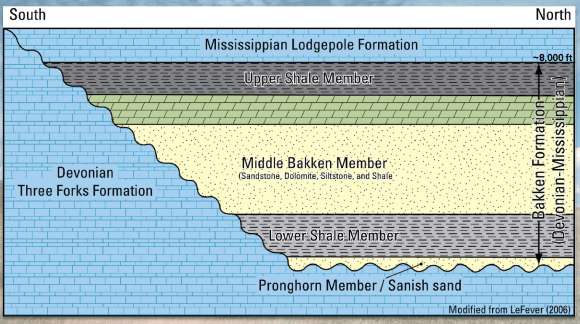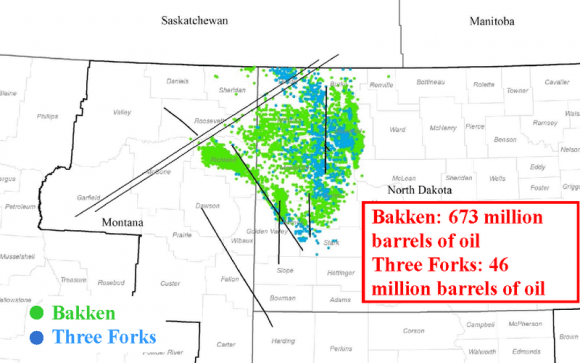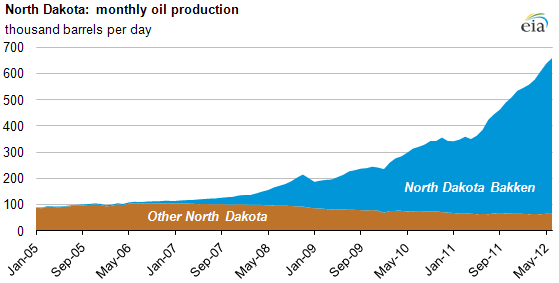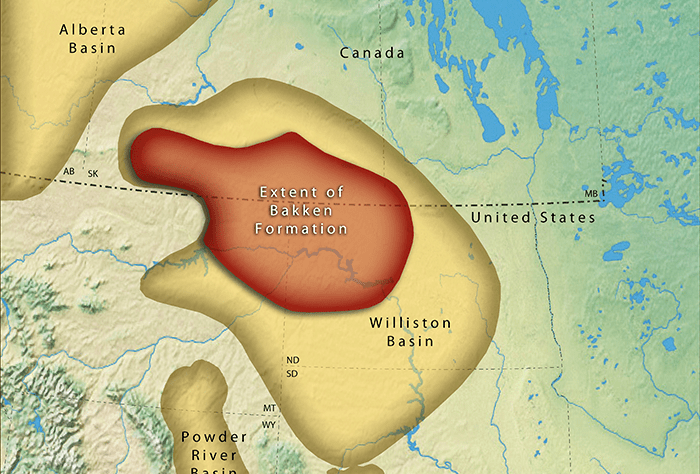There has certainly been a lot of talk over the past few decades about this thing known as the “energy crisis”. In essence, we’re being told that fossil fuels are running low, that we need to start thinking green and about alternative fuels and renewable resources.
However, there’s also been a lot of discussion about places like Alberta Tar Sands and other North American oil deposits, and how these might meet our energy needs for the foreseeable future. One such deposit is the Bakken Formation, a rock unit occupying about 520,000 km² (200773 square miles) of the Williston Basin, which sits beneath parts of Saskatchewan, Manitoba, Montana, and North Dakota.
On the geologic timescale, the rock formation is believed to date from the late Devonian to Early Mississippian age – from roughly 416 to 360 million years ago. It was discovered in 1953 by a geologist named J.W. Nordquist and named after Henry Bakken, owner of the Montana farm where Nordquist first drilled.

This rock formation consists of three members or strata: the lower shale, middle dolomite, and upper shale. Oil was first discovered there in 1951, but pumping it met with difficulties. This is due to the fact that the oil itself is principally found in the middle dolomite member – roughly 3.2 km (two miles) below the surface – where it is trapped in layers of non-porous shale, making the process both difficult and expensive.
While it was postulated as early as 1974 that the Bakken could contain vast amounts of petroleum, it wasn’t until Denver-based geologist Leigh Price did a field assessment for the U.S. Geological Survey (USGS) in 1995 that official estimates were made. Price estimated in 1999 that the Bakken Formation contained between 271 and 503 billion barrels of petroleum.
Impressive, yes? Well, keep in mind that the percentage of this oil that could actually be extracted is debatable. In 1994, estimates ranged from as low as 1% to Price’s estimate of 50%. A more recent report filed in 2008 by the USGS placed the amount at between 3.0 to 4.3 billion barrels (680,000,000 m3), with a mean of 3.65 billion.

By 2011, a senior manager at Continental Resources Inc. (CLR) raised that estimate to an overall at 24 billion barrels, claiming that the “Bakken play in the Williston basin could become the world’s largest discovery in the last 30–40 years”.
But reports issued by both the USGS and the state of North Dakota in April 2013 were more conservative, estimating that up to 7.4 billion barrels of oil could be recovered from the Bakken and Three Forks formations using current technology.
Still, this represents a significant increase from the estimates made back in 1995. Horizontal well and hydraulic fracturing technology have helped, adding about 70 million barrels of production in 7 years in Montana and North Dakota. By 2007, Saskatchewan was also experiencing a boom, producing five million barrels in that year, which was up 278,540 barrels in 2004.
Consistent with the US’ policy of achieving “energy independence”, analyst expect that an additional $16 billion will be spent to further develop the Bakken fields in 2015. The large increase in tight oil production is one of the reasons behind the price drop in late 2014, and keeping prices low is always politically popular.

As more wells are brought online, production will continue to increase in places like North Dakota. While the rate of production per well appears to have peaked at 145 barrels a day since June of 2010, the number of wells has also doubled in the region between then and December of 2011.
The increase in oil and natural gas extraction has also had a profound increase on the economy of North Dakota. In addition to leading a reduction in unemployment, it has given the state a billion-dollar budget surplus and a GDP that is 29% above the national average. However, there has also been the resulting rise in pollution and the strain that industrialization and a population surge has put on the states’ water supply.
Will any of this solve the “energy crisis”? Hard to say. Because of the highly variable nature of shale reservoirs and shale drilling, and the fact that per-well rates seem to have peaked, it seems unlikely that total Bakken production will grow much further or affect the imports of foreign oil.
And given how the price of alternatives like solar, wind, geothermal and tidal energy are dropping all the time, one can expect that a fossil fuel-economy will become something of a fossil itself someday!
We have written many articles about the Bakken Formation for Universe Today. Here’s an article about Alternative Energy Sources, and here’s an article about harvesting solar power from space.
If you’d like more info on the Bakken Formation, check out the U.S. Geological Survey Homepage. And here’s a link to NASA’s Earth Observatory.
We’ve also recorded an episode of Astronomy Cast all about planet Earth. Listen here, Episode 51: Earth.
Sources:
http://en.wikipedia.org/wiki/Bakken_Formation – cite_note-usgs.gov-3
http://www.cbc.ca/money/story/2008/05/23/f-langton-bakken.html
http://www.theoildrum.com/node/3868
http://www.thestar.com/Business/article/414164

